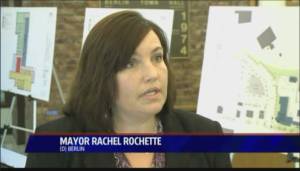Mayor Rachel Rochette of Berlin, Connecticut, may have her facts wrong about the Berlin Police Department
On Monday, August 25, 2014 in an interview with John Charlton of Fox Connecticut News, Berlin Mayor, Rachel Rochette, presented her case for a new police station by suggesting that the present Berlin police station is too small for the present number of Berlin police employees since “it was built in 1972, and it was built for a police force of fourteen officers and two support staff.” But according to the Berlin Police Department’s own website, the main premise of her argument may rest on erroneous facts.
According to that website, the current police station was not occupied by the Berlin Police Department in 1972. “May 15, 1975 saw the relocation of the police department from Murray Heights to the newly constructed Municipal Complex on Kensington Road.” Furthermore, if one adds up all the employees who were added to the police department, in that year there appears to be twenty-seven full-time police officers, and two clerks; not fourteen police officers and two clerks, as reported by Mayor Rachel Rochette.
Moreover, according to the information on the same website, in 1976 the department added four more full-time officers, bringing the grand total of police employees to thirty-three. It is not unreasonable to assume that these additions of police officers, or at the very least their need, were recognized, if not anticipated, in the immediately preceding year; consequently, it is not at all unlikely that the current police station was designed and constructed for an intended occupancy of at least thirty-three employees, and not merely for sixteen employees, as asserted by Mayor Rachel Rochette. That difference in design capacity represents a police station accommodating 100% more police employees than what Mayor Rachel Rochette stated on the televised evening news the other night.
Needless to say, that difference in original design capacity impacts the argument of whether Berlin’s Police Department has outgrown its present facility. If it were merely designed for sixteen employees, Mayor Rochette’s argument would be much more difficult to refute; however, if it were designed for at least thirty-three employees, if not more, then perhaps the Berlin Police Department has not outgrown the current police station but may have grown disproportionately and unnecessarily large in size as required by the growth of population of Berlin.
Consider the population growth in Berlin since 1976. It increased by ~35% since that time. If the size of the police staff now had remained in the same proportion to the population as it were in 1976, the police department would now have ~45 employees instead of the 55 officers and support staff currently employed in our police department. The fact that this number of police department employees is comparable to that in Farmington, Connecticut, even though Farmington’ population is ~20% larger than that of Berlin, lends some credence to the 45 staff size as the appropriately required number of employees in Berlin’s Police Department in relation to its population size.
If no more than 45 employee are absolutely necessary to operate Berlin’s Police Department, a more viable, less costly alternative to building a new police station in order to accommodate the lack of room at the current Police Department may be simply to lay off some police employees as well as to dispose of and/or to arrange for offsite storage of riot helmets, body armor, chemical equipment, SWAT rifles, etc. This might save many millions of dollars for Berlin’s taxpayers from not having to spend an additional $23 million plus on a new police station as well as from the significant reduction in police salaries and fringe benefits over many years resulting from the layoffs.
What may be disconcerting to some Berlin citizens is that Mayor Rachel Rochette may have predicated her argument for the need for a new police station on materially incorrect facts. And if indeed a mayor of a town does not have one’s specific facts straight, then how can the citizens of that town be expected to have confidence in the merit of that mayor’s position in support of a very expensive project, which may have significant financial ramifications for its taxpaying citizens?
It is customarily expected, especially for elected officials, to get one’s facts straight first in order to avoid misinforming and misleading those whom one governs, and, equally as important, in order to avoid making a decision leading to unnecessary costs for them.

Leave a comment